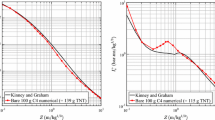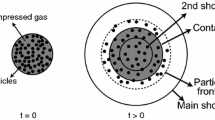Abstract
The evolution of a particle cloud following its interactions with a blast wave and contact interface resulting from a detonating high-energy explosive is a difficult problem for both numerical simulations and physical experiments. In experiments, it is challenging to accurately characterize both the initial states of the explosive and the surrounding particle bed. There are also limitations in the available diagnostic tools and measurable data which can be extracted from the experiments. Thus, simulations are a cheaper alternative where the physics governing the interactions between the expanding particle cloud and the highly compressible, post-detonation fluid flow can be analyzed. Using multiphase, compressible flow simulations in an Eulerian–Lagrangian frame, the impact of introducing perturbations to a particle bed surrounding an explosive charge is studied. The analysis focuses on the multiphase instabilities and late-time behavior displayed by the particle cloud and discusses the associated underlying physical phenomena. The effects of these instabilities on the behavior of the mixing between the detonation products and the surrounding air are also discussed. The perturbations are varied to reveal the effects of the initial particle distribution and its persistence in the later-time particle cloud and the background fluid flow.



















Similar content being viewed by others
References
Bdzil, J.B., Stewart, D.S.: The dynamics of detonation in explosive systems. Annu. Rev. Fluid Mech. 39, 263–292 (2007). https://doi.org/10.1146/annurev.fluid.38.050304.092049
Zeldovich, Y.B.: To the theory of detonation propagation in gas systems. J. Exp. Theor. Phys. 10(5), 542–568 (1940)
Zhang, F., Frost, D., Thibault, P., Murray, S.: Explosive dispersal of solid particles. Shock Waves 10(6), 431–443 (2001). https://doi.org/10.1007/PL00004050
Frost, D.L., Gregoire, Y., Petel, O., Goroshin, S., Zhang, F.: Particle jet formation during explosive dispersal of solid particles. Phys. Fluids 24(9), 091109 (2012). https://doi.org/10.1063/1.4751876
Ripley, R., Donahue, L., Zhang, F.: Jetting instabilities of particles from explosive dispersal. AIP Conf. Proc. 1426, 1615–1618 (2012). https://doi.org/10.1063/1.3686594
Frost, D.L., Loiseau, J., Marr, B.J., Goroshin, S.: Particle segregation during explosive dispersal of binary particle mixtures. AIP Conf. Proc. 1793, 120020 (2017) https://doi.org/10.1063/1.4971702
Hughes, K., Balachandar, S., Diggs, A., Haftka, R., Kim, N., Littrell, D.: Simulation-driven design of experiments examining the large-scale, explosive dispersal of particles. Shock Waves 30(4), 325–347 (2020). https://doi.org/10.1007/s00193-019-00927-x
Milne, A., Parrish, C., Worland, I.: Dynamic fragmentation of blast mitigants. Shock Waves 20(1), 41–51 (2010). https://doi.org/10.1007/s00193-009-0235-5
Milne, A., Floyd, E., Longbottom, A., Taylor, P.: Dynamic fragmentation of powders in spherical geometry. Shock Waves 24(5), 501–513 (2014). https://doi.org/10.1007/s00193-014-0511-x
Milne, A., Longbottom, A., Frost, D., Loiseau, J., Goroshin, S., Petel, O.: Explosive fragmentation of liquids in spherical geometry. Shock Waves 27(3), 383–393 (2017). https://doi.org/10.1007/s00193-016-0671-y
Frost, D.: Heterogeneous/particle-laden blast waves. Shock Waves 28(3), 439–449 (2018). https://doi.org/10.1007/s00193-018-0825-1
McFarland, J.A., Black, W.J., Dahal, J., Morgan, B.E.: Computational study of the shock driven instability of a multiphase particle-gas system. Phys. Fluids 28(2), 024105 (2016). https://doi.org/10.1063/1.4941131
Rodriguez, V., Saurel, R., Jourdan, G., Houas, L.: Solid-particle jet formation under shock-wave acceleration. Phys. Rev. E 88(6), 063011 (2013). https://doi.org/10.1103/PhysRevE.88.063011
Black, W., Denissen, N., McFarland, J.: Particle force model effects in a shock-driven multiphase instability. Shock Waves 28(3), 463–472 (2018). https://doi.org/10.1007/s00193-017-0790-0
Osnes, A.N., Vartdal, M., Reif, B.P.: Numerical simulation of particle jet formation induced by shock wave acceleration in a Hele–Shaw cell. Shock Waves 28(3), 451–461 (2018). https://doi.org/10.1007/s00193-017-0778-9
Vorobieff, P., Anderson, M., Conroy, J., White, R., Truman, C.R., Kumar, S.: Vortex formation in a shock-accelerated gas induced by particle seeding. Phys. Rev. Lett. 106(18), 184503 (2011). https://doi.org/10.1103/PhysRevLett.106.184503
Anderson, M., Vorobieff, P., Truman, C., Corbin, C., Kuehner, G., Wayne, P., Conroy, J., White, R., Kumar, S.: An experimental and numerical study of shock interaction with a gas column seeded with droplets. Shock Waves 25(2), 107–125 (2015). https://doi.org/10.1007/s00193-015-0555-6
Rayleigh, L.: On the stability, or instability, of certain fluid motions. Proc. Lond. Math. Soc. 1(1), 57–72 (1879). https://doi.org/10.1112/plms/s1-11.1.57
Taylor, G.: The instability of liquid surfaces when accelerated in a direction perpendicular to their planes. I. Proc. R. Soc. Lond. A Math. Phys. Eng. Sci. 201(1065), 192–196 (1950). https://doi.org/10.1098/rspa.1950.0052
Richtmyer, R.D.: Taylor instability in shock acceleration of compressible fluids. Commun. Pure Appl. Math. 13(2), 297–319 (1960). https://doi.org/10.1002/cpa.3160130207
Meshkov, E.: Instability of the interface of two gases accelerated by a shock wave. Fluid Dyn. 4(5), 101–104 (1969)
Middlebrooks, J.B., Avgoustopoulos, C.G., Black, W.J., Allen, R.C., McFarland, J.A.: Droplet and multiphase effects in a shock-driven hydrodynamic instability with reshock. Exp. Fluids 59(6), 98 (2018). https://doi.org/10.1007/s00348-018-2547-7
Black, W.J., Denissen, N.A., McFarland, J.A.: Evaporation effects in shock-driven multiphase instabilities. J. Fluids Eng. 139(7), 071204 (2017). https://doi.org/10.1115/1.4036162
McFarland, J.A., Hagenmaier, M.: Computational study of shock-driven multiphase mixing in scramjet conditions. AIAA J. 56(10), 4004–4015 (2018). https://doi.org/10.2514/1.J056548
Balakrishnan, K.: Explosion-driven Rayleigh–Taylor instability in gas–particle mixtures. Phys. Fluids 26(4), 043303 (2014). https://doi.org/10.1063/1.4873175
Annamalai, S., Rollin, B., Ouellet, F., Neal, C., Jackson, T.L., Balachandar, S.: Effects of initial perturbations in the early moments of an explosive dispersal of particles. J. Fluids Eng. 138(7), 070903 (2016). https://doi.org/10.1115/1.4030954
Ouellet, F., Annamalai, S., Rollin, B.: Effect of a bimodal initial particle volume fraction perturbation in an explosive dispersal of particles. AIP Conf. Proc. 1793, 150011 (2017) https://doi.org/10.1063/1.4971740
Fernández-Godino, M.G., Ouellet, F., Haftka, R.T., Balachandar, S.: Early time evolution of circumferential perturbation of initial particle volume fraction in explosive cylindrical multiphase dispersion. J. Fluids Eng. 141(9), 091302 (2019). https://doi.org/10.1115/1.4043055
Liou, M.-S.: A sequel to AUSM, Part II: AUSM+-up for all speeds. J. Comput. Phys. 214(1), 137–170 (2006). https://doi.org/10.1016/j.jcp.2005.09.020
Haselbacher, A.: A WENO reconstruction algorithm for unstructured grids based on explicit stencil construction. 43rd AIAA Aerospace Sciences Meeting and Exhibit, Reno, NV, AIAA Paper 2005-0879 (2005) https://doi.org/10.2514/6.2005-879
Ling, Y., Haselbacher, A., Balachandar, S.: Transient phenomena in one-dimensional compressible gas-particle flows. Shock Waves 19(1), 67–81 (2009). https://doi.org/10.1007/s00193-009-0190-1
Ling, Y., Haselbacher, A., Balachandar, S.: Importance of unsteady contributions to force and heating for particles in compressible flows: Part 1: Modeling and analysis for shock–particle interaction. Int. J. Multiph. Flow 37(9), 1026–1044 (2011). https://doi.org/10.1016/j.ijmultiphaseflow.2011.07.001
Ling, Y., Haselbacher, A., Balachandar, S.: Importance of unsteady contributions to force and heating for particles in compressible flows. Part 2: application to particle dispersal by blast waves. Int. J. Multiph. Flow 37(9), 1013–1025 (2011). https://doi.org/10.1016/j.ijmultiphaseflow.2011.07.002
Garno, J., Ouellet, F., Bae, S., Jackson, T.L., Kim, N.-H., Haftka, R., Hughes, K.T., Balachandar, S.: Calibration of reactive burn and Jones–Wilkins–Lee parameters for simulations of a detonation-driven flow experiment with uncertainty quantification. Phys. Rev. Fluids 5(12), 123201 (2020). https://doi.org/10.1103/PhysRevFluids.5.123201
Parmar, M., Haselbacher, A., Balachandar, S.: Improved drag correlation for spheres and application to shock-tube experiments. AIAA J. 48(6), 1273–1276 (2010). https://doi.org/10.2514/1.J050161
Parmar, M., Haselbacher, A., Balachandar, S.: On the unsteady inviscid force on cylinders and spheres in subcritical compressible flow. Philos. Trans. R. Soc. Lond. A Math. Phys. Eng. Sci. 366(1873), 2161–2175 (2008). https://doi.org/10.1098/rsta.2008.0027
Parmar, M., Haselbacher, A., Balachandar, S.: Generalized Basset–Boussinesq–Oseen equation for unsteady forces on a sphere in a compressible flow. Phys. Rev. Lett. 106(8), 084501 (2011). https://doi.org/10.1103/PhysRevLett.106.084501
Annamalai, S., Balachandar, S.: Faxén form of time-domain force on a sphere in unsteady spatially varying viscous compressible flows. J. Fluid Mech. 816, 381–411 (2017). https://doi.org/10.1017/jfm.2017.77
Clift, R., Gauvin, W.: The motion of particles in turbulent gas streams. Proc. Chemeca 1, 14–28 (1970)
Sangani, A.S., Zhang, D., Prosperetti, A.: The added mass, basset, and viscous drag coefficients in nondilute bubbly liquids undergoing small-amplitude oscillatory motion. Phys. Fluids A Fluid Dyn. 3(12), 2955–2970 (1991). https://doi.org/10.1063/1.857838
Ling, Y., Wagner, J., Beresh, S., Kearney, S., Balachandar, S.: Interaction of a planar shock wave with a dense particle curtain: modeling and experiments. Phys. Fluids 24(11), 113301 (2012). https://doi.org/10.1063/1.4768815
Patankar, N., Joseph, D.: Modeling and numerical simulation of particulate flows by the Eulerian–Lagrangian approach. Int. J. Multiph. Flow 27(10), 1659–1684 (2001). https://doi.org/10.1016/S0301-9322(01)00021-0
Harris, S., Crighton, D.: Solitons, solitary waves, and voidage disturbances in gas-fluidized beds. J. Fluid Mech. 266, 243–276 (1994). https://doi.org/10.1017/S0022112094000996
Jones, H., Miller, A.: The detonation of solid explosives: the equilibrium conditions in the detonation wave-front and the adiabatic expansion of the products of detonation. Proc. R. Soc. A: Math. Phys. Eng. Sci. 194(1039), 480–507 (1948). https://doi.org/10.1098/rspa.1948.0093
Wilkins, M.: The equation of state of PBX 9404 and LXO4-01. Lawrence Radiation Laboratory, Livermore, Rept. UCRL-7797 (1964)
Lee, E., Hornig, H., Kury, J.: Adiabatic expansion of high explosive detonation products. Lawrence Radiation Lab, California University, Livermore, UCRL-50422 (1968). https://doi.org/10.2172/4783904
Dobrat, B., Crawford, P.: Handbook, LLNL explosives. Lawrence Livermore National Laboratory (1985)
Thompson, K.W.: Time dependent boundary conditions for hyperbolic systems. J. Comput. Phys. 68(1), 1–24 (1987). https://doi.org/10.1016/0021-9991(87)90041-6
Poinsot, T.J., Lele, S.K.: Boundary conditions for direct simulations of compressible viscous flows. J. Comput. Phys. 101(1), 104–129 (1992). https://doi.org/10.1016/0021-9991(92)90046-2
Rodriguez, V., Saurel, R., Jourdan, G., Houas, L.: Impulsive dispersion of a granular layer by a weak blast wave. Shock Waves 27(2), 187–198 (2017). https://doi.org/10.1007/s00193-016-0658-8
Wagner, J.L., Beresh, S.J., Kearney, S.P., Trott, W.M., Castaneda, J.N., Pruett, B.O., Baer, M.R.: A multiphase shock tube for shock wave interactions with dense particle fields. Exp. Fluids 52(6), 1507–1517 (2012). https://doi.org/10.1007/s00348-012-1272-x
Vorobieff, P., Rightley, P.M., Benjamin, R.F.: Shock-driven gas curtain: fractal dimension evolution in transition to turbulence. Phys. D: Nonlinear Phenom. 133(1–4), 469–476 (1999). https://doi.org/10.1016/S0167-2789(99)00079-2
Ng, H.D., Abderrahmane, H.A., Bates, K.R., Nikiforakis, N.: The growth of fractal dimension of an interface evolution from the interaction of a shock wave with a rectangular block of SF6. Commun. Nonlinear Sci. Numer. Simul. 16(11), 4158–4162 (2011). https://doi.org/10.1016/j.cnsns.2011.03.016
Zhou, Y.: Rayleigh–Taylor and Richtmyer–Meshkov instability induced flow, turbulence, and mixing. II. Phys. Rep. 723, 1–160 (2017). https://doi.org/10.1016/j.physrep.2017.07.008
Mikaelian, K.O.: Rayleigh–Taylor and Richtmyer–Meshkov instabilities and mixing in stratified cylindrical shells. Phys. Fluids 17(9), 094105 (2005). https://doi.org/10.1063/1.2046712
Wei, T., Livescu, D.: Effects of initial conditions on single and two-mode Rayleigh–Taylor instabilities. Presented at Turbulent Mixing and Beyond Third International Conference, Trieste, Italy (2011)
Acknowledgements
This work was supported by the U.S. Department of Energy, National Nuclear Security Administration, Advanced Simulation and Computing Program, as a Cooperative Agreement under the Predictive Science Academic Alliance Program, under Contract No. DE-NA0002378.
Author information
Authors and Affiliations
Corresponding author
Additional information
Communicated by R. Bonazza.
Publisher's Note
Springer Nature remains neutral with regard to jurisdictional claims in published maps and institutional affiliations.
Rights and permissions
About this article
Cite this article
Ouellet, F., Rollin, B., Koneru, R.B. et al. Effects of perturbing the particle volume fraction distribution in blast-driven multiphase instability. Shock Waves 31, 337–360 (2021). https://doi.org/10.1007/s00193-021-01023-9
Received:
Revised:
Accepted:
Published:
Issue Date:
DOI: https://doi.org/10.1007/s00193-021-01023-9




